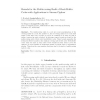27 search results - page 2 / 6 » Bounds on the Covering Radius of Linear Codes |
CORR
2010
Springer
13 years 4 months ago
2010
Springer
The maximum-likelihood decoding problem is known to be NP-hard for general linear and Reed-Solomon codes [1, 4]. In this paper, we introduce the notion of A-covered codes, that is...
STOC
2009
ACM
14 years 5 months ago
2009
ACM
We give explicit constructions of epsilon nets for linear threshold functions on the binary cube and on the unit sphere. The size of the constructed nets is polynomial in the dime...
JCT
2002
13 years 4 months ago
2002
An asymmetric binary covering code of length n and radius R is a subset C of the n-cube Qn such that every vector x Qn can be obtained from some vector c C by changing at most R...
DCC
2001
IEEE
14 years 4 months ago
2001
IEEE
The multicovering radii of a code are recent generalizations of the covering radius of a code. For positive m, the m-covering radius of C is the least radius t such that every m-tu...
TIT
2002
13 years 4 months ago
2002
Abstract--Informally, an error-correcting code has "nice" listdecodability properties if every Hamming ball of "large" radius has a "small" number of ...

